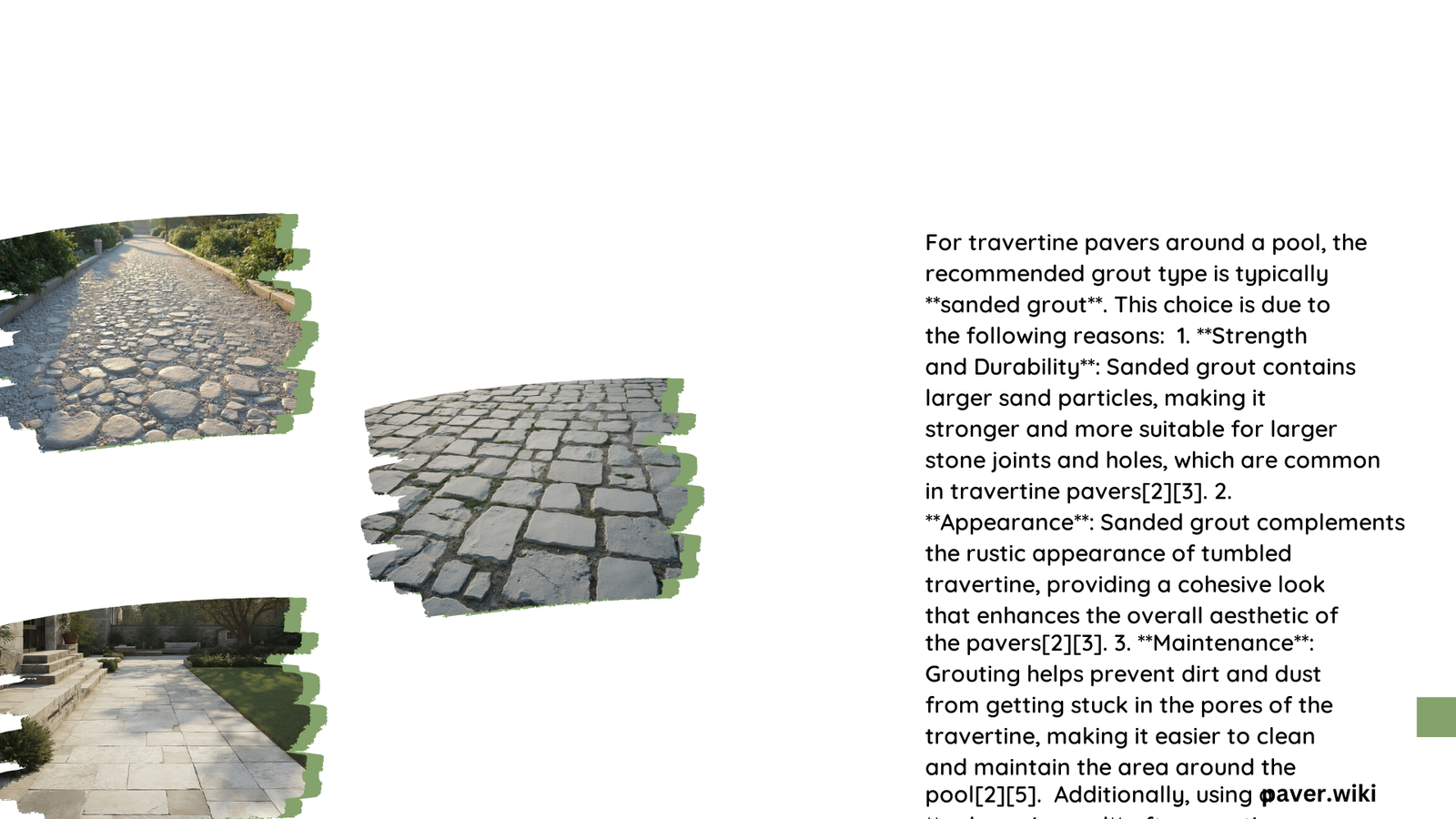When installing travertine pavers around a pool, choosing the right grout is crucial for durability and aesthetics. Sanded grout is typically recommended due to its strength and water resistance. Epoxy grout offers superior longevity and low maintenance, while flexible grout provides better resistance to movement and cracking. The choice depends on factors such as climate, pool usage, and desired appearance.
What Are the Best Grout Options for Travertine Pavers Around Pools?
Sanded Grout
Sanded grout is a popular choice for travertine pavers around pools due to its durability and water resistance. Here are some key points about sanded grout:
- Composition: Contains fine sand particles for added strength
- Joint width: Ideal for joints wider than 1/8 inch
- Durability: Resistant to shrinkage and cracking
- Water resistance: Suitable for wet areas like pool surrounds
Epoxy Grout
Epoxy grout offers superior performance in pool environments:
- Stain resistance: Highly resistant to chemicals and stains
- Durability: Extremely hard-wearing and long-lasting
- Water resistance: Virtually impermeable to water
- Low maintenance: Requires less cleaning and upkeep than traditional grouts
Flexible Grout
Flexible or polymer-modified grout is another excellent option:
- Flexibility: Able to withstand movement without cracking
- Weather resistance: Suitable for outdoor use in various climates
- Bonding strength: Provides strong adhesion to travertine pavers
- Crack resistance: Less prone to cracking than traditional grouts
What Factors Should Be Considered When Choosing Grout for Pool Pavers?

When selecting grout for travertine pavers around a pool, consider the following factors:
- Climate: Choose a grout that can withstand your local weather conditions
- Pool usage: Consider the level of foot traffic and exposure to pool chemicals
- Aesthetic preferences: Select a grout color that complements your travertine pavers
- Maintenance requirements: Evaluate how much time and effort you’re willing to invest in grout upkeep
- Budget: Compare costs of different grout types and installation methods
How Does Grout Color Affect the Overall Appearance of Travertine Pavers?
The color of grout can significantly impact the look of your travertine paver pool deck:
- Matching color: Creates a seamless appearance
- Contrasting color: Highlights individual pavers and patterns
- Light colors: Reflect more light, making the area appear brighter
- Dark colors: Can hide dirt and stains more effectively
Consider creating a small test area with different grout colors to see which best complements your travertine pavers.
What Are the Steps to Properly Grout Travertine Pavers Around a Pool?
Follow these steps for successful grouting of travertine pavers:
- Clean and dry the pavers thoroughly
- Mix the grout according to manufacturer’s instructions
- Apply grout using a rubber float, pressing firmly into joints
- Allow grout to set for 15-20 minutes
- Clean excess grout with a damp sponge
- Allow grout to cure completely (usually 24-48 hours)
- Apply sealer to both grout and pavers for added protection
How Much Grout is Needed for Travertine Pavers Around a Pool?
To estimate the amount of grout needed, consider these factors:
- Paver size: Larger pavers require less grout
- Joint width: Wider joints need more grout
- Total area: Calculate the square footage of your pool deck
Use this formula as a general guide:
Grout needed (in pounds) = (Square footage of area) x (Joint width in inches) x (Joint depth in inches) x 2
Always purchase extra grout to account for waste and potential miscalculations.
What Are the Common Challenges in Grouting Travertine Pavers Around Pools?
Grouting travertine pavers around pools can present several challenges:
- Moisture control: Ensuring the area is dry before grouting
- Temperature fluctuations: Extreme temperatures can affect grout curing
- Uneven surfaces: Travertine’s natural texture can make grouting more difficult
- Staining: Improper sealing can lead to stained grout or pavers
- Efflorescence: Mineral deposits can form on grout and pavers
To overcome these challenges, work in small sections, follow manufacturer guidelines closely, and consider hiring a professional for best results.
How Can Grout Be Maintained in a Pool Environment?
Proper maintenance is crucial for long-lasting grout in pool areas:
- Regular cleaning: Sweep and rinse the area weekly
- Deep cleaning: Use a pH-neutral cleaner monthly
- Sealing: Reapply sealer annually or as recommended by the manufacturer
- Prompt repairs: Address any cracks or damage immediately
- Chemical balance: Maintain proper pool water chemistry to prevent grout degradation
By following these maintenance practices, you can extend the life of your grout and keep your travertine paver pool deck looking beautiful for years to come.
